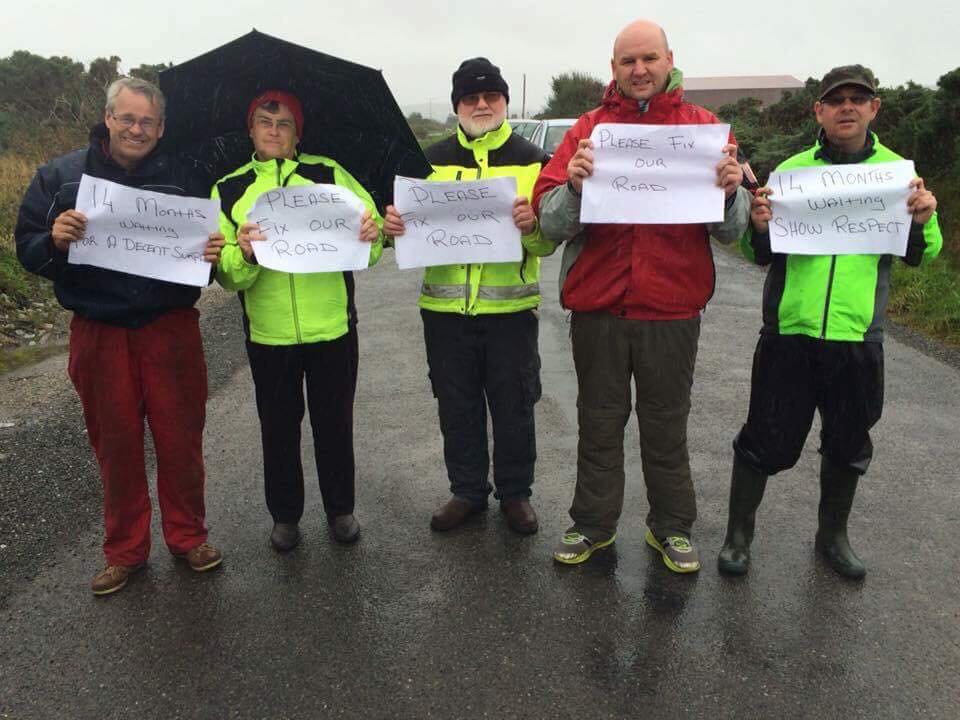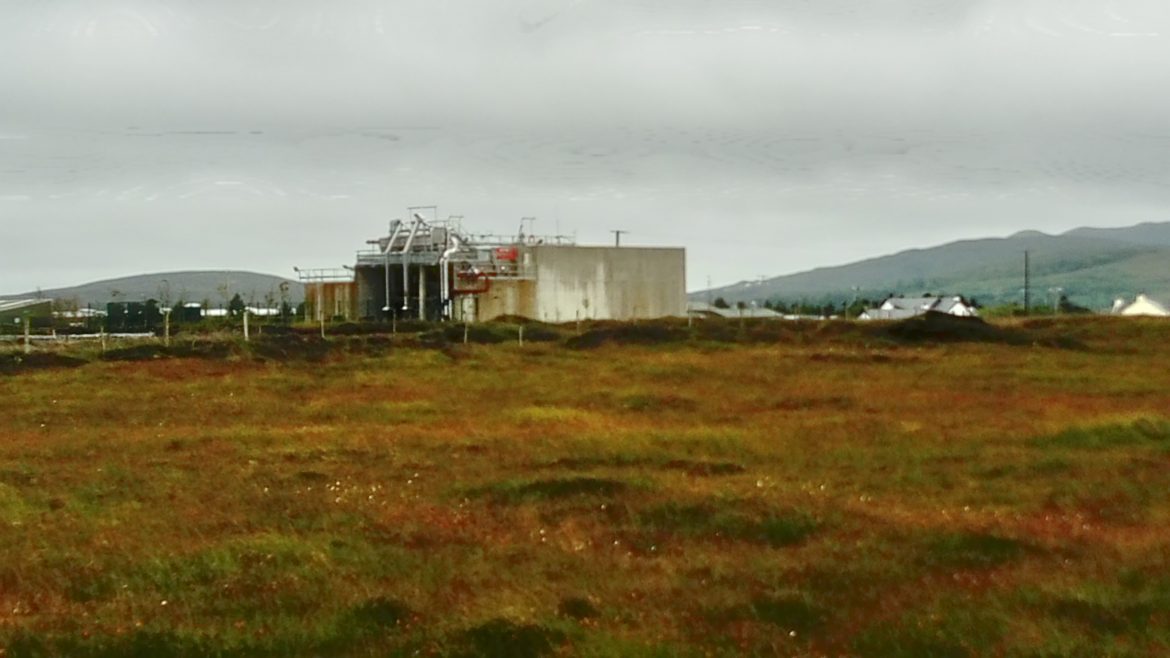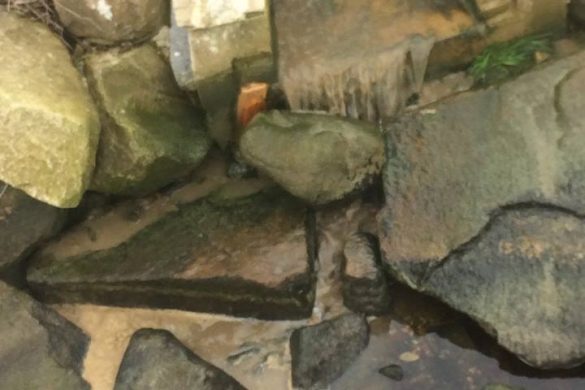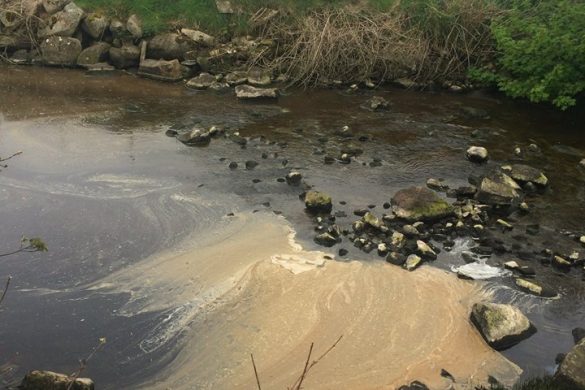On Saturday morning residents of the Meenmore area of Dungloe were disgusted to find that the effluent contained in the newly opened waste water treatment plant on the Pole Road had overflowed over the sides of the facility.
Meenmore resident Hugh Boyle, who has worked in waste water treatment for seventeen years, explained to Donegal Daily how his concerns that the plans for the proposed water treatment plant were too small, which were ignored in 2007, have now materialised.
The potential threat to public health from waste water is at the heart of the residents’ concerns. As the water oozed from the structure on Saturday morning, it blew towards four existing homes downwind to the north of the facility.
Irish Water were contacted by Councillor Michael Cholm MacGiolla Easbuig on Saturday morning and an emergency meeting has been arranged.
€7.2 million of funding for two waste water treatment plants in Glenties and Dungloe were announced by Irish Water to replace the outdated septic tank system.
When this was announced, Irish Water say that “the new [wastewater treatment] plants will ensure treated effluent meets EPA standards and will also allow for future population growth and economic development in the areas.”

Picture by Elaine Mc Callig
They also stated that the benefits of the construction of the facilities are as follows; “To provide wastewater treatment capacity for the Catchment Area for a planning horizon of twenty years including preliminary treatment, secondary treatment and phosphorous and ammonia removal; To comply with current E.U. Directives relating to Wastewater Treatment of discharges from urban agglomerations; To make adequate provisions for this vital infrastructure to facilitate the overall growth and physical development of the town and surrounding areas.”
In 2007, residents in Meenmore became aware of the plans lodged to construct a treatment plant in the area, and although many residents were wary, Hugh explained that as he was aware of the importance of properly treated water, he convinced his neighbours to embrace the decision.
“I felt the proposal would have no negative impact on anyone in the area. There was meant to be a pumping station included to serve the closest houses to the treatment plant, but this never materialised. We assumed we would get a facility that was fit for purpose.
“I feel misled, and I feel partly responsible for the potential health threat on my neighbours’ doorsteps as I campaigned for this in 2007. This is just not acceptable.
“How is it being monitored? Where were the alarms on Saturday morning?”
In 2007, the Meemore residents were told that all they would see is a picket fence, trees, and a small peak of a shed; that it would be underground. The structure now however, towers over Meenmore.
In March 2014, Independent Councillor Mac Giolla Easbuig accompanied Hugh to a meeting at the Public Service Centre in Dungloe where a panel was open to questions of the public regarding the new Dungloe Sewerage Scheme.
During this meeting, Hugh says he became aware that what had been agreed in 2007 had been altered completely.
“I asked the panel why the pumping station to serve the closest houses to the treatment plant had been excluded, and the contractors explained that it would come during the next phase of development. I then asked about the size of the plant, and how they calculated the estimated capacity, and whether the calculations based solely on the population equivalent.
“The most concerning part for me was when I asked how they estimated the volume of storm water which would enter the pipework would be. No one had the answer to this question for me. I asked if a flow meter was used to calculate this, and the answer was yes. When I asked what pipe was the flow meter fixed to – I was told it was fitted to the main sewer.
“However, to accurately calculate the volume of storm water you would need a flow meter on every stormwater pipe that is connected to the town sewer.
“At this stage, I realised there would be a very serious issue around sizing.
“I asked would it be possible to get sight of the flow meter calculations, this never materialised.”
Later that year, in July, heavy rainfall hit the Rosses.
“The level and force of storm water that entered the old septic system was such that it blew the lids off the old tanks, confirming my fear that storm water would have a serious impact on the Dungloe sewerage system.
“We never realised we would have to face this. What happened on Saturday morning adds to my fears that the treatment plant undersized. To me, this is similar to what occurred in 2014 when the lids were blown off, but there are no lids on this building, so it seeped out over the side of the building.”
Donegal County Council told Hugh that the facility is constructed on piles, and requires no lateral support from the surrounding peat layer, and that the condition of the ground will not impact the structure, however anxieties remain amongst residents over the integrity of the ground the plant is built on. This anxiety is due to the uninhabitable 15-house Radharc an Seascan estate located just across the road, locally referred to as “the sinking estate” and the “Titanic estate”; now a ghost estate.
“In the meantime during construction, we understood that the road would be damaged and that with periodic maintenance it would remain passable. This didn’t happen. Over the last two years, there has been no sign of improvement. Although I wrote to Donegal County Council, nothing was improving. Along with other residents, we blocked the road in protest.”

Meenmore residents and Cllr Mac Giolla Easbuig at a previous protest
The road works were scheduled to be completed in February or March 2017 “subject to settlement”, however they have now been rescheduled until August.
“Although the road is a major issue, it pales in comparison to what we saw on Saturday morning when the effluent seeped over the walls”, Hugh explained.
In a statement to Donegal Daily, a spokesperson for Irish Water says that it is unlikely that a similar incident will happen again.
“Irish Water can confirm that a minor incident occurred at the Dungloe Wastewater Treatment Plant last Saturday where an automated inlet valve to one of the treatment tanks in the plant failed to close fully on Saturday morning which led to the spillage of effluent within the plant. This incident has been reported to the EPA and the issue was resolved within hours.
“Repairs to the valve were completed by 2pm on Saturday and the likelihood of this incident reoccurring is low following steps that were taken to ensure an automatic shutdown of the inlet pumps if the value fails to close in the future.
“Irish Water can confirm that the pollution was contained within the confines of the waste water treatment plant site. There was no impact to the surrounding environment as a result of this incident which happened following a period of heavy rainfall which led to more diluted than normal incoming wastewater. The receiving area surrounding the wastewater treatment plant is bog and marsh with no immediate drain or river flowing in to a water source.”
The way the waste water treatment process works is as follows; first the water is screened and larger objects such as nappies and sanitary towels are removed. The water then goes in to a settlement tank, where human waste settles at the bottom as sludge, and fats and greases rises to the top. Next, the wastewater receives tertiary treatment which encourages the growth of a bacteria which decomposes any remaining toxic waste. It is then filtered or dosed with a suitable chemical before being released into the river.
The entrance of excess storm water can disrupt the water treatment process, as the water is not allowed sufficient time for the sludge to separate from the fats and greases.
Beside Dungloe playground, the water is released. However images show that the water does not appear to be as pure as one would expect after an adequate treatment.
There is a concern that this may harm the wildlife, as well as the people, who inhabit and frequent the Dungloe bay area.
Councillor Mac Giolla Easbuig has called for an emergency meeting with Irish Water to discuss these issues and has lodged a freedom of information request regarding what method was used to calculate the potential maximum daily wastewater loading, and why the treatment plant was not located at the site of the old wastewater treatment and disposal facility that served Dungloe.
Featured image by Elaine Mc Callig.
Tags:









